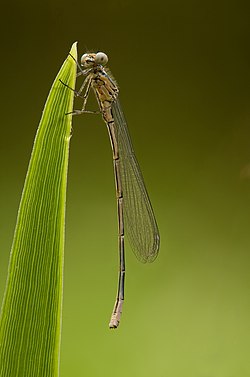Males
Adult male azure damselflies have a head and thorax patterned with blue and black. They have an azure blue abdomen patterned with black markings. The marking on the second segment of the abdomen is U-shaped, separated from the segment's narrow terminal black band; this distinguishes it from the variable damselfly Coenagrion pulchellum where the U-shape is joined to the terminal band with a black line. [1]
Segments three to five are blue with broader black terminal bands, lacking the forward-pointing projection the upper surface which adult male common blue damselfly has. Segment six has a similar pattern but with more restricted blue and a broader area of black, and segment seven is mostly black, with just a narrow blue area at the base. Segment eight and much of segment nine are sky-blue, forming a noticeable contrasting patch, but there are small dark markings on the rear upper side of segment nine, which adult male common blue damselfly does not possess.
immature
juvenile
young adult male











